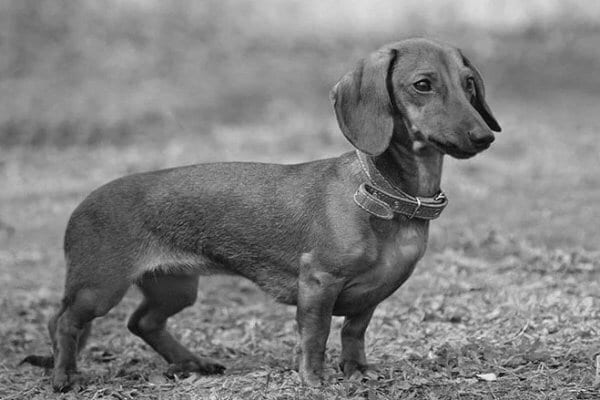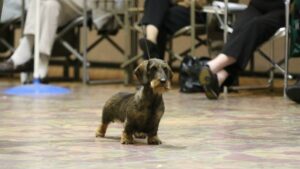
Judging the Dachshund
Learn how to judge Dachshunds: from conformation to movement. Discover breed standards & tips for accurate assessment.

Home » Meet The Breeds » Dachshund Dog Breed
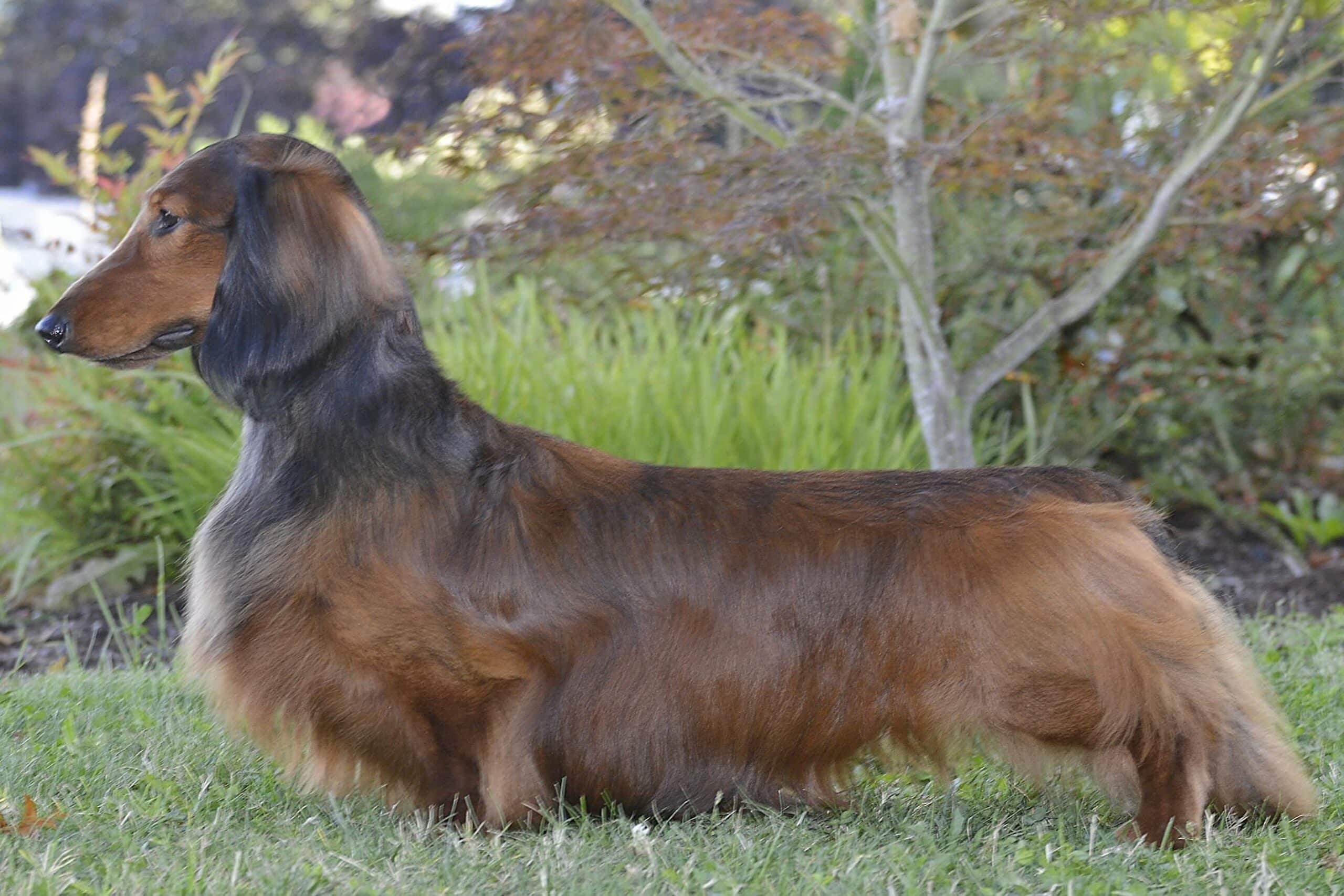



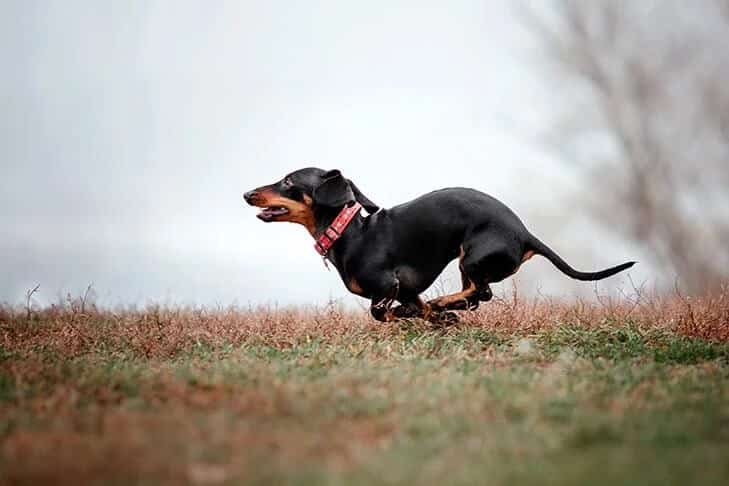
The Dachshund, affectionately referred to as the “doxie” (or “wiener dog” or “sausage dog” due to its unique and easily recognizable shape), has captivated hearts around the world. Originating from Germany, this breed was initially designed for hunting small to medium-sized game, particularly badgers. Its distinctive physique, characterized by a long back and short legs, served it well in navigating narrow burrows. Today, the Dachshund remains a beloved family companion, celebrated both for its unique appearance and its spirited demeanor.
Hound
5-9 Inches
Under 32 Pounds
12-16 Years
| Country of Origin | Germany |
|---|---|
| Bred For | Vermin Hunting, Companionship |
| Known For | Long Body & Short Legs, Foolhardiness, Hunting Spirit |
| Popularity | High |
| Activities | Hunting, Field Trials, Hiking, Digging, Conformation Shows, Dog Sports |
The Dachshund, with its distinctive physique and spirited demeanor, boasts a rich history that spans centuries. This breed’s tale is woven with threads of courage, hunting prowess, and a unique physique, earning it the admiration of people around the world.
Originating in Germany, the Dachshund’s name itself provides a clue to its primary function: Dachs translates to “badger” in German, while hund means “dog.” Crafted for their fearless nature and agile build, these dogs were initially bred for badger hunting. The breed’s elongated body and short legs allowed the Dachshund to dig into badger dens, while its robust and courageous temperament equipped it to take on such a formidable opponent.
Over time, variations in the Dachshund’s size were developed to suit different hunting needs. While the standard-sized dog pursued badgers and wild boar, the miniature version was used for hunting small game like hares.
The Dachshund wasn’t solely confined to the forests and fields of Germany. By the 1800s, the breed had piqued the interest of dog enthusiasts in other parts of Europe and soon made its way to the United States. Its unique appearance, combined with its spirited nature, made the Dachshund popular both as a hunting partner and family companion.
The 20th century saw the Dachshund’s popularity rise and fall. During the World Wars and in the years that followed, anti-German sentiment negatively impacted the breed’s popularity. However, its many charms were undeniable, and it wasn’t long before the Doxie found itself back in the hearts of dog lovers everywhere.
The American Kennel Club (AKC) granted the breed official recognition in the early 1900s. Similarly, the Federation Cynologique Internationale (FCI) and The Royal Kennel Club (UK) have long recognized the Dachshund for its distinctive appearance and spirited demeanor.
Today, the Dachshund stands not just as a testament to specialized breeding for hunting but as a beloved companion in countless households. The breed’s journey from the dense forests of Germany to the cozy living rooms of families worldwide is a testimony to its adaptability, charisma, and enduring appeal.
A Dachshund can be categorized based on its size: Miniature or Standard. A mature Standard Dachshund typically measures around 8 to 9 inches tall at the shoulder, with males weighing between 16 and 32 pounds and females usually ranging from 16 to 28 pounds. Adult Miniature Dachshunds are notably smaller, standing around 5 to 6 inches tall at the shoulder, with both males and females generally weighing less than 11 pounds at 12 months of age. In Germany, a third size is also recognized. Adult “Rabbit” Dachshunds generally weigh up to 7.7 pounds for males and 6.6 pounds for females.
The Dachshund’s elongated body and short legs are characteristics that are not produced merely for aesthetic appeal. They serve a functional purpose rooted in the breed’s history as a hunting dog. The unique silhouette makes it immediately clear that this is a dog designed for function, and its well-balanced height-to-length ratio ensures that, even with a long and low to ground body, the Dachshund can move in a fluid and robust manner.
A well-muscled body is evidence of the Dachshund’s origins as a tenacious worker. Its compact yet robust form is sturdy, ensuring the ability to navigate tight spaces during hunting escapades. Substance, combined with the dog’s unique proportions, embodies the essence of the breed; a powerful hunter in a compact frame.
Texture: The Dachshund boasts three distinct coat varieties: Smooth, Longhaired, and Wirehaired. Each presents its own charms and texture:
The Dachshund comes in a vibrant palette of colors:
| Standard Color | |
|---|---|
| Black & Tan | ee |
| Chocolate & Tan | ee |
| Cream | ee |
| Wheaten | ee |
| Wild Boar | ee |
| Red | ee |
| Blue & Tan | ee |
| Fawn (Isabella) & Tan | ee |
| Black & Cream | ee |
| Black | ee |
| Chocolate | ee |
| Fawn (Isabella) & Cream | ee |
| Chocolate & Cream | ee |
| Blue & Cream | ee |
| Fawn | ee |
Unacceptable (Fad) Color & Pattern: The following color/pattern is unacceptable in the Dachshund:
A Note About Color: The most common Dachshund colors are wild boar, black & tan, and various shades of red. Wild boar, also called agouti, has banding of the individual hairs and is most common on the Wirehaired variety. Tan points may or may not be evident, and variations include red boar and chocolate-and-tan boar. The nose, nails, and eye rims are black on these colors and self-colored on chocolate-and tanboar dogs. Except for Piebalds, white hair may appear only on the chest, although it is not desirable.
| Standard Marking | |
|---|---|
| Brindle | ee |
| Dapple | ee |
| Pie Bald | ee |
| Sable | ee |
| Brinde Piebald | ee |
The head of the Dachshund is elegantly shaped and carried confidently, symbolizing the breed’s keen sense of alertness and determination.
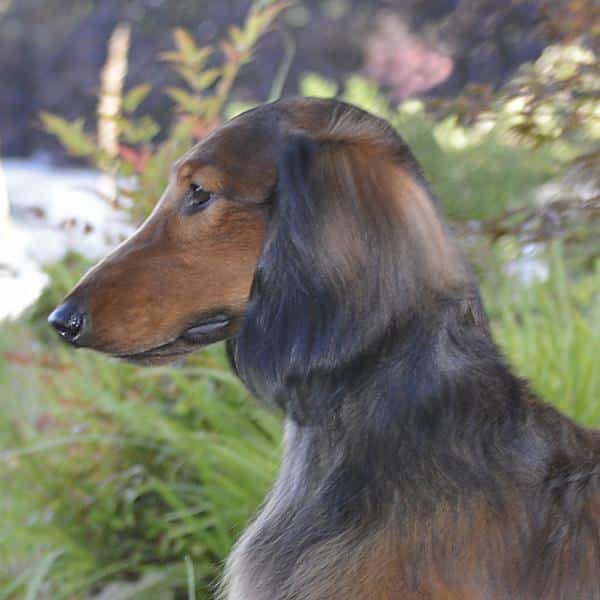
The Dachshund’s tail is a continuation of its spine, extending without any pronounced curvature. It’s set and carried in line with the topline, neither drooping nor raised. The tail is well-balanced, not too thick or thin, and tapers towards the tip. Its length reaches the hock joints when extended.
Covered uniformly with the same coat type as the rest of the body, the tail can display markings or patterns that match the body’s coloration. The Dachshund’ tail is a distinctive breed feature, providing balance and adding length to the breed’s unique silhouette.
Dachshunds, with their distinctive appearance and spirited nature, can be both a joy and a challenge for owners. The breed’s history as a tenacious hunter translates into a strong personality in the modern household setting. Owners should be prepared for a dog that is both fiercely loyal and sometimes stubborn. Before embarking on the journey of owning a Dachshund, it’s crucial to consider the breed’s unique needs and characteristics, thus ensuring a harmonious relationship for both person and pet.
Generally, Dachshunds are robust and healthy dogs, but like all breeds and mixed breeds, they can be prone to certain health issues. Regular check-ups with a veterinarian can help to detect and manage any potential problems early on.
Lifespan: On average, a Dachshund will live between 12 to 16 years. With proper care, regular vet visits, and a balanced diet, many can live healthy and fulfilling lives well into their teens.
Dachshunds, though small and sturdy, do have a set of health concerns that potential and current owners should be aware of:
Given the unique health challenges that Dachshunds can face, it’s recommended that owners schedule regular veterinary visits, at least once a year, for a general health check-up. Being proactive and attentive to the dog’s health can ensure early detection and effective management of any potential health issues. For senior Dachshunds or those with known health conditions, more frequent visits might be necessary. Regular dental check-ups, often done annually, are also vital for preventing several diseases.
The Dachshund, affectionately nicknamed the “wiener dog” because of its distinctive shape, boasts a personality as unique as its appearance. Here’s a glimpse into the multifaceted temperament of this delightful breed:
While Dachshunds are undeniably loving and loyal, their suitability for novice owners comes with a caveat. Their notorious stubbornness might present a challenge, but with patience and consistent training, first-time dog owners will find a rewarding companion in the breed.
At their core, Dachshunds are sensitive souls. They form profound attachments to their families, sometimes becoming wary of strangers and unfamiliar settings. This heightened sensitivity can lead to anxiety, particularly if they experience prolonged periods of solitude.
The idea of leaving a Dachshund alone for extended durations isn’t ideal. These companions thrive in the presence of their loved ones and can show signs of separation anxiety, which might manifest as destructive behaviors or incessant barking.
Historically hunters, Dachshunds can display signs of aggression towards other dogs, especially if they feel threatened. However, with diligent socialization from a young age, they can often coexist peacefully with other household pets. They are, however, typically amicable with familiar dogs and, when raised together, form strong bonds with them.
When it comes to young children, Dachshunds are generally patient. However, due to their unique build, it’s essential for children to understand the importance of gentle handling. Rough or careless play can inadvertently harm these small dogs.
As for their reception of strangers, Dachshunds are naturally protective. Their initial reaction might involve barking or cautious behavior. But with proper introductions and repeated positive interactions, most dogs will eventually warm up, showcasing the breed’s affectionate and playful nature.
Feeding a Dachshund properly is paramount, not just for the dog’s health but also in terms of managing its predisposition to certain conditions, like obesity which can further exacerbate spinal issues.
When considering feeding a Dachshund puppy, it’s essential to provide a diet that supports the breed’s growth. Puppies usually need a formula specifically designed for small breeds, one that is rich in proteins, fats, and essential nutrients to ensure they develop strong muscles and bones.
Transitioning from a puppy food to an adult diet should be done gradually and typically starts at around the age of 12 months. An adult Dachshund’s diet should be balanced, emphasizing lean proteins, healthy fats, and complex carbohydrates. It’s also vital to monitor the puppy’s weight closely, as this breed can quickly become overweight, leading to additional health concerns.
Regarding the amount of food, the specific quantity can vary based on the Dachshund’s size, activity level, and age. Generally, an average adult Dachshund might consume anywhere from one-half to one and a half cups of high-quality dog food daily, divided into two meals. It’s best to consult with a veterinarian to determine the exact amount suited for the individual dog.
For those interested in a feeding chart, many premium dog food brands offer specific guidelines based on the dog’s weight. This can serve as a starting point, but it’s essential to monitor each Dachshund’s weight individually and adjust portions as necessary.
Training a Dachshund presents a unique set of challenges and rewards. While the breed’s intelligence is undeniable, its independent nature, combined with a hint of stubbornness, requires a specific approach to training.
The Dachshund’s intelligence is evident in its ability to pick up commands quickly. However, the ease with which a Dachshund learns also means these dogs can be adept at picking up unwanted behaviors if not guided correctly. Positive reinforcement, consistency, and patience are key when training this breed.
A frequent question raised by potential Dachshund owners is the breed’s tendency to bark. While it’s true that Dachshunds are alert dogs with a pronounced bark for their size, this trait can be managed. Early training, to differentiate between perceived threats and general occurrences, can help with reducing unnecessary barking.
Another aspect to consider is the breed’s wanderlust potential. Historically bred for hunting, the Dachshund’s keen sense of smell can lead these dogs on scent-driven adventures if not supervised. A secure yard and leashed walks are essential to prevent them from wandering off.
In terms of predation, the breed’s hunting heritage is often evident. Smaller animals like rodents might trigger their chase instinct. Early socialization, especially with other household pets, can mitigate this behavior to some extent.
Given the breed’s independent streak, some people might wonder if Dachshunds are easy to train. While they aren’t inherently defiant, their intelligence, combined with a certain willfulness, means they might occasionally test boundaries. However, with a firm, consistent approach that’s also filled with praise and rewards, Dachshunds can become well-trained and obedient companions.
Exercise is a crucial aspect of a Dachshund’s life. While these dogs might be small in stature, the breed’s energetic and spirited nature means they require regular activity to stay healthy and content.
| Energy Level | High |
|---|---|
| Exercise Requirements | 1 Hour/Day (Minimum), Daily Walks, Regular Exercise, Playing with Another Dog, Mental Stimulation |
Dachshunds have a fair need for exercise, often surprising many with their stamina. Regular walks, play sessions, and even light agility activities can be excellent ways to keep them physically active and mentally stimulated.
While Dachshunds possess a fair amount of energy, the intensity of their exercise sessions should be monitored. Due to their elongated backs, activities that put excessive strain on their spines, like jumping from high places or rough play, should be avoided. Instead, focusing on controlled activities like brisk walks, games of fetch on level ground, and even hide and seek can offer them the exercise they crave without the potential harm.
The playful nature of the Dachshund is undeniable. Whether it’s chasing a ball or engaging in a tug-of-war, play sessions offer not only physical activity but also provide an opportunity for bonding and training.
However, while they love play and activity, Dachshunds can also be content with lounging and cuddling sessions, especially after they’ve had their dose of daily exercise. It’s important to strike a balance that prevents them from becoming either overexerted or overweight.
Grooming a Dachshund isn’t just about maintaining its appearance; it’s also an essential part of the dog’s overall health and well-being. While Dachshunds might not have the high maintenance coat of some breeds, regular grooming is vital to ensure they remain clean, comfortable, and healthy.
| Coat Type | Smooth |
|---|---|
| Grooming Requirements | Weekly Brushing, Occasional Bathing, Routine Ear Cleaning, Periodic Nail Trimming, Regular Tooth Brushing |
One of the unique aspects of the Dachshund is that the breed’s coat can come in three varieties: Smooth, Longhaired, and Wirehaired. Each variety has its own specific grooming requirements.
For Smooth Dachshunds, grooming is relatively straightforward. This variety’s short, sleek coat benefits from regular brushing, ideally once a week, to remove loose hair and distribute natural oils. This not only keeps the coat shiny, it also reduces the amount of shedding.
Longhaired Dachshunds, on the other hand, have a silky, flowing coat that requires more attention. To prevent tangles and matting, this variety should be brushed several times a week. Additionally, occasional trims, especially around the ears, legs, and tail, can help to maintain an elegant appearance.
Wirehaired Dachshunds present a unique grooming challenge. This variety’s coarse coat is dense and needs regular brushing to remove dead hair and prevent matting. Moreover, Wires benefit from a process called “hand-stripping” to maintain the coat’s texture and color. This involves plucking out the old, dead hair, thus making way for new growth.
Regardless of the coat type, other grooming essentials for the Dachshund include regular nail trims, ear cleaning, and dental care. Keeping the nails short will prevent potential foot problems, and clean ears will ward off a variety of infections. As with all breeds, oral hygiene is crucial, so regular tooth brushing or dental chews can help to support healthy teeth and gums.
The Dachshund, with its small size and adaptable nature, makes for a versatile companion suitable for various living conditions. However, understanding the breed’s specific needs can ensure every dog thrives in its environment.
Apartment living is generally well-suited for the Dachshund. The breed’s compact size means it can comfortably live in smaller spaces. However, regardless of the dwelling’s size, regular exercise remains a must to keep the dog physically healthy and mentally stimulated.
When considering the climate, Dachshunds are relatively adaptable. The breed can manage in cold weather, especially the Longhaired and Wirehaired varieties which have a protective coat. However, precautions should be taken during extreme periods of cold, such as providing them with a warm doggy sweater or limiting their outdoor time. On the flip side, in hot weather, it’s essential to provide them with a cool, shaded place to rest and avoid midday walks when the sun is at its peak.
Dachshunds, with their hunting lineage, have a natural curiosity. This means they can often be found exploring their surroundings. A safe, secure yard or garden can become paradise, allowing the dogs to sniff and roam freely. However, it’s vital to guarantee that the area is escape-proof, as the Dachshund’s digging instincts and smaller size can lead them to find unexpected exit routes.
Inside the home, care should be taken to ensure the Dachshund’s safety, especially considering its elongated back. Avoid allowing these dogs to jump off high furniture, and make sure that stairways are always navigated safely. Some Dachshund owners opt for ramps or steps to assist their pets with accessing higher places without risk.
There’s a special kind of joy that Dachshund puppies bring. With their floppy ears, curious eyes, and playful antics, these lively little “weiners” have a way of quickly becoming the center of attention. However, as with all puppies, the early stages of a Doxie’s life are crucial for their development and well-being.
Welcoming a Dachshund puppy into the home is an exciting experience filled with energetic play and heartwarming moments. Providing the spirited little one with proper care during the formative weeks and months is vital for its overall development and happiness.
Proper nutrition is essential for raising a healthy Dachshund puppy. The breed’s unique body structure demands a diet that promotes strong bone and joint development. Opting for specialized puppy formulas, particularly those tailored for small breeds, can provide each puppy with the right balance of nutrients that is crucial for steady growth.
As the Dachshund puppy begins to explore the world, early socialization becomes paramount. Introducing the pup to a variety of sights, sounds, people, and other animals in a positive manner helps to shape its temperament, making the youngster more confident and well-adjusted as it grows.
While every puppy is undeniably endearing, each comes equipped with a sharp mind and a touch of stubbornness. Starting basic obedience training early can help to channel the puppy’s intelligence in the right direction, laying the foundation for a well-behaved adult Dachshund.
Safety is another significant aspect of puppy care. The adventurous spirit of a Dachshund puppy can lead it into unexpected nooks and crannies. It’s essential to puppy-proof the home, ensuring potential hazards, small objects, and toxic substances are always out of reach.
Consistent health checks play a crucial role in these early stages. Regular visits to the vet provide each puppy with vital vaccinations, deworming treatments, and overall health evaluations. These preventive measures set the stage for a long and healthy life.
Lastly, the importance of an early grooming routine can’t be overstated. Introducing a Dachshund puppy to gentle brushing and occasional baths will not only keep it looking its best, it will also acclimatize the pup to the grooming process, making future sessions a pleasure for both dog and groomer.
The Dachshund, with its hunting origins and spirited nature, enjoys a variety of activities that not only keep it physically fit but also mentally stimulated. Here are some activities and dog sports in which the breed often excels:
Engaging a Dachshund in these activities can provide a well-rounded exercise routine that caters to the dog’s physical and mental needs. It’s essential to remember, however, that due to the breed’s unique body structure, activities should be approached with safety in mind, ensuring no undue stress is placed on the dog’s back and legs.
The Dachshund is recognized by the world’s leading registries and kennel organizations, which categorize the breed into a specific Group based on its unique characteristics. This breed is recognized worldwide under the following Group designations:
| Organization | Group Designation |
|---|---|
| AKC (American Kennel Club) | Hound |
| UKC (United Kennel Club) | Scenthound |
| CKC (Canadian Kennel Club) | Hound |
| ANKC (Australian National Kennel Council) | Hounds |
| RKC (The Royal Kennel Club) | Hound |
| FCI (Fédération Cynologique Internationale) | Group 4 – Dachshunds |
The ideal Dachshund is described by a Breed Standard that is approved by each of the world’s leading registries and kennel organizations. The Breed Standards for this breed may be found in the following links:
| Organization | Breed Standard |
|---|---|
| American Kennel Club | AKC Dachshund Breed Standard |
| United Kennel Club | UKC Dachshund Breed Standard |
| Canadian Kennel Club | CKC Dachshund Breed Standard |
| Australian National Kennel Council | ANKC Dachshund Breed Standard |
| The Royal Kennel Club | RKC Dachshund Breed Standard |
| Fédération Cynologique Internationale | FCI Dachshund Breed Standard |
Breed clubs play a pivotal role in promoting, preserving, and educating enthusiasts about the Dachshund. These organizations are committed to the breed’s health and well-being, and to upholding the Breed Standards, ensuring its rich history and distinctive qualities are celebrated for generations to come.
In the United States, the most prominent organization dedicated to this breed is the Dachshund Club of America (DCA). Established with a commitment to advancing the interests of the breed, the DCA holds various events, provides education, and offers resources to breeders, exhibitors, and owners.
In the United Kingdom, the Dachshund Club stands as one of the oldest breed clubs, having been established in the late 19th century. It remains an influential voice in matters concerning the breed, from sponsoring health initiatives to holding competitive events.
Membership or affiliation with these clubs can be an invaluable resource for any Dachshund enthusiast. These organizations provide opportunities for networking, learning, and participating in events that celebrate the many facets of this remarkable breed.
Rescue groups play a vital role in providing second chances to Dachshunds that have been displaced, abandoned, or surrendered. Their commitment goes beyond rehoming; they also focus on rehabilitation, medical care, and ensuring that each dog finds a loving and appropriate home.
Across the United States, there are numerous rescue groups dedicated to the breed. Dachshund Rescue of North America (DRNA) is one of the foremost organizations committed to the rescue, rehabilitation, and rehoming of Dachshunds. Their network of volunteers stretches across the country, providing Dachshunds in need with loving homes.
Another notable organization is the All American Dachshund Rescue (AADR). This group has made considerable strides in rehoming dogs across the country and also provides education and resources for prospective adopters.
In addition to these national organizations, there are numerous local and state-specific rescue groups that tirelessly work for the well-being of the breed. Adopting a Dachshund not only provides a home for a dog in need, it also creates space for other Dachshunds in need of loving care as they transition to their forever homes.
The Dachshund can be an excellent family dog when introduced to a home environment that understands the breed’s unique temperament. Dachshunds are often affectionate and playful, and they can get along well with children, especially if raised with them from a young age. However, it’s crucial for families to make sure the children handle Dachshunds gently to avoid injuring the dogs’ long backs.
Dachshunds are known for their loyalty and can sometimes become particularly attached to one family member. While they can bond with the entire family, they often select a “favorite” person whom they follow around and display a deeper connection with. However, with consistent socialization and interaction, they can become more evenly affectionate with all family members.
Like many dogs, most Dachshunds prefer company and can suffer from separation anxiety if left alone for extended periods. If it’s necessary to leave a Dachshund alone regularly, it’s essential to ensure it has toys and activities to keep it occupied. Training and gradual acclimation to alone time can also reduce stress and destructive behaviors.
Dachshunds have a robust bark for their size, a trait inherited from their early days spent alerting hunters to their quarry. They can be quite vocal and are often quick to bark at unfamiliar noises or visitors. Training and early socialization can help to manage these barking tendencies.
Yes, Dachshunds are natural diggers. Their original purpose was to hunt burrowing animals, and this digging instinct remains strong. It’s not uncommon to find a Doxie digging in the yard or even burrowing into blankets or sofa cushions.
While any dog can bite under certain circumstances, Dachshunds are not inherently aggressive. However, they can be protective and, sometimes, more than a bit stubborn. Proper training, socialization, and understanding their signals and needs can greatly reduce the risk of biting incidents.
The maintenance level for a Dachshund can vary based on a dog’s size and coat type. Smooth Dachshunds require minimal grooming, making them relatively low maintenance in that aspect. By contrast, Longhaired and Wirehaired Dachshunds need more regular grooming. In terms of temperament and behavior, the breed’s lively and sometimes headstrong nature often requires consistent training and constant attention.

Learn how to judge Dachshunds: from conformation to movement. Discover breed standards & tips for accurate assessment.

Explore Linda the Dachshund’s breed versatility in hog baying, highlighting the balance between purposeful breeding and breed integrity.
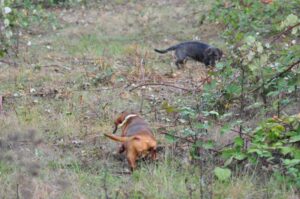
To obtain a Field Trial Championship for Dachshunds you must accumulate a total of 35 points, three placements, and one first place.
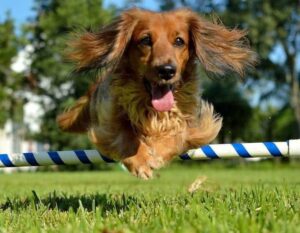
When “Gee!” was conceived, little did I know the journey on which she would take me. I wanted a Triple Champion. Gee! said, “Hold my beer!”

Earthdog tests provide a venue so that all dog owners can test and evaluate their dogs’ ability to do the job for which they are bred.

Showsight Magazine’s Allan Reznik talks with Margaret Peat of Pramada Dachshunds, on her history with the breed, spanning back to the early
The best way to ensure a long and happy relationship with a purebred dog is to purchase one from a responsible breeder. Not sure where to begin?
Contact the National Parent Club’s Breeder Referral Program, which is listed on the AKC Breeder Referral Contacts page.
